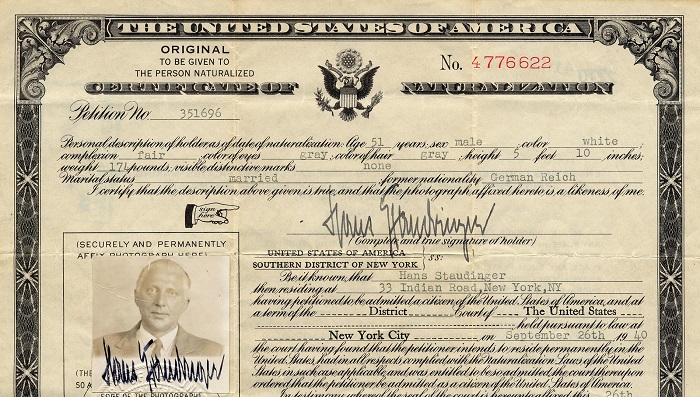This series contains documents, several selections of diary entries, photographs and curriculum vita of Bates. The documents pertaining to Roy C. Bates (Kurt Bauchwitz) date from 1890 to 1974 with later documents pertaining to Barbara Bates (third wife), which date through 1995. Included in the collection are many early documents such as birth certificates, early school documents, marriage certificates from Bates/Bauchwitz' first two marriages in Germany, as well as university and military service documents. Also in the collection are a number of documents which record Bates/Bauchwitz' legal career as well as his subsequent dismissal from his post by the Hitler regime in 1938. His period of flight from Nazi Germany is also well-documented, as well as his early years in the U.S., including his naturalization as a U.S. citizen in 1946. Also included in this section are documents pertaining to his university studies in the U.S. at Columbia, St. John's and New York Universities. Completing the biographical section of this series are a number of curriculum vita, several biographical statements prepared for planned editions of Bates' poetry, as well as a number of photographs.
Collections : [German and Jewish Intellectual Émigré Collections]
German and Jewish Intellectual Émigré Collections
Personal and professional papers of German-speaking Émigré in the social sciences, humanities, and the arts and the organizations which assisted those who fled the Nazi regime.
In recognition of the serious scholarly interest in the mass migration of German speaking exiles from the Nazi regime, a German and Jewish Intellectual Émigré Collection was established in 1976 at the University at Albany, State University of New York. This growing collection has been developed since the 1970s through the efforts of the University Libraries and Professor John M. Spalek of the University's Germanic and Slavic Languages and Literature Department
Search Constraints
Start Over You searched for: Online Content Online Content Remove constraint Online Content: Online Content Collecting Area German and Jewish Intellectual Émigré Collections Remove constraint Collecting Area: German and Jewish Intellectual Émigré Collections Date range 1930 to 1931 Remove constraint Date range: <span class="from" data-blrl-begin="1930">1930</span> to <span class="to" data-blrl-end="1931">1931</span>Search Results
Erich Hula Papers, 1900-1986 22 cubic ft.
A substantial portion of the Erich Hula Papers consists of his writings, both in typescript and published form. This includes his contributions to newspapers and journals as well as extensive notes from his research and for courses taught. The collection also contains correspondence files and biographical documents, and a large collection of reprints (and some typescripts) sent to and collected by Hula of colleagues and other scholars.
Erich von Kahler Papers, 1905-1977 13 cubic ft.
This collection contains diaries, 1906-1913; correspondence; corrected manuscripts of literary works by Hermann Broch, Golo Mann, and others, 1945-1970; lecture notes on philosophy of history; and contemporary politics for lectures given in Germany and the United States.
Erwin Bodky Papers, 1897-1958 6 cubic ft.
The Bodky Papers include biographical materials, letters, musical programs, reviews, extensive manuscripts, arrangements, and printed material. Bodky studied piano with Ferrucio Busoni and composition with Richard Strauss and performed widely on harpsichord and piano. He left Germany and lived in the Netherlands, 1933–1938, and the United States from 1938 until his death. He was a professor of music at Brandeis University.
Eugene I. Rabinowitch Papers, 1923-1973 14 cubic ft.
Russian-born chemist and SUNY Albany professor who worked on the Manhattan Project, was an early leader of the Concerned Scientists Movement, and helped organize the Pugwash Conferences on Science and World Affairs. The Rabinowitch Papers document various aspects of his life and career and contain his writings, his involvement with the Pugwash Conferences and the Bulletin of the Atomic Scientists, his research interests in photosynthesis, and his work at the University of Illinois and the State University of New York at Albany.
Fritz Neugass Papers, 1913-1979 60 cubic ft.
The collection documents the professional life of photographer and journalist Fritz Neugass. The Neugass Papers include published writings, typescripts, clippings, research materials, photographs by Neugass, photographs by others, correspondence, and auction catalogs.
Hans Natonek Papers, 1918-1964 3.25 cubic ft.
The Hans Natonek Papers contain drafts of his novels, short stories and poems, and correspondence with family and publishers. The bulk of the literary works in this collection, though undated, stem from the period after Natonek fled to the United States, mainly after he moved to Arizona in 1943.
Hans Speier Papers, 1922-1989 16.5 cubic ft.
The Hans Speier Papers primarily focus on Speier's career in the U.S. after his emigration. The collection includes biographical materials, including family documents and correspondence; autobiographical writings, manuscripts and typescripts; The RAND Corporation materials; typescripts by other authors, Nazi propaganda; anti-Nazi propaganda; Allied Forces Intelligence reports and memoranda; notes and materials on various topics; and political pamphlets.
